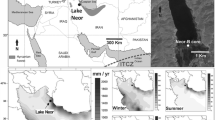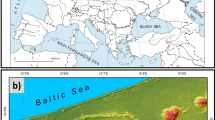Abstract
Analysis of the distributions of chironomid (midge) and other dipteran subfossils from two high elevation lake sediment cores in the Cascade Mountains reveals changes in midge communities and inferred climate since the late-glacial. Cabin Lake and 3M Pond are located near treeline in the subalpine Engelmann Spruce/Subalpine Fir biogeoclimatic zone of British Columbia. In Cabin Lake, chironomid head capsule assemblages depict a typical late-glacial community, and three distinct Holocene communities. In Cabin Lake, the late-glacial community is composed of cold-stenothermous taxa dominated by Stictochironomus, Mesocricotopus, Heterotrissocladius, Parakiefferiella nigra, Protanypus and Paracladius, whereas warm water midges are absent or rare, indicating cold conditions. A late-glacial chironomid community was not found in 3M Pond. In both lakes the early Holocene is dominated by a diverse warm-adapted assemblage, corresponding to the warm climatic conditions of the xerothermic period. Cabin Lake's mid-Holocene zone records a decrease in relative abundance of the warm water types and is accompanied by an increase in cold-stenotherms. At 3M Pond this period shows a dramatic loss in diversity of warm-adapted taxa, as the temperate genus Dicrotendipes dominates. This zone corresponds to Hebda's (1995) mesothermic period. Further cooling in the late Holocene (to modern conditions) is inferred from continued reduction of warm water midges and persistence (at Cabin Lake) or appearance (at 3M Pond) of a cold-stenothermal community. This late Holocene cooling is similar in timing to Neoglacial advances in the Coast, Cascade, and Rocky Mountains of southern British Columbia. Similarities in the timing of chironomid and vegetation community changes at these high elevation sites, along with the more rapid response time of the Chironomidae, support the sensitivity of midges to postglacial climatic change at high elevation sites.
Similar content being viewed by others
References
Alley, R. B., P. A. Mayewski, T. Sowers, M. Stuiver, K. C. Taylor & P. U. Clark, 1997. Holocene climatic instability: A prominent, widespread event 8200 yr ago. Geology 25: 483–486.
Arno, S. F. & R. P. Hammerly, 1984. Timberline — Mountain and Arctic Forest Frontiers. The Mountaineers, Seattle, 304 pp.
Bradley, R. S., 1985. Quaternary Paleoclimatology. Allen and Unwin Inc., London, 472 pp.
Brown, T. A., D. E. Nelson, R. W. Mathewes, J. S. Vogel & J. R. Southon, 1989. Radiocarbon dating of pollen by accelerator mass spectrometry. Quat. Res. 32: 205–212.
Clague, J. J., S. G. Evans, V. N. Rampton & G. J. Woodsworth, 1995. Improved age estimates for the White River and Bridge River tephras, western Canada. Can. J. Earth Sci. 32: 1172–1179.
Coffman, W. P., 1984. Chironomidae, In R.W. Merritt & K.W. Cummins (eds), An Introduction to the Aquatic Insects of North America, 2nd ed. Kendall/Hunt, Dubuque: 551–652.
Danks, H. V. & D. R. Oliver, 1972a. Seasonal emergence of some high arctic Chironomidae (Diptera). Can. Entomol. 104: 661–686.
Danks, H. V. & D. R. Oliver, 1972b. Diel periodicities of emergence of some high arctic Chironomidae (Diptera). Can. Entomol. 104: 903–916.
Epler, J. H., 1988. Biosystematics of the genus Dicrotendipes Kieffer, 1913 (Diptera: Chironomidae: Chironominae) of the world. Mem. Am. Entomol. Soc. 36: 1–214.
Grimm, E. C., 1987. CONISS: a FORTRAN 77 program for stratigraphically constrained cluster analysis by the method of incremental sum of squares. Comp. Geosci. 13: 13–35.
Grimm, E. C., 1993. TILIAGRAPH 1.25 (computer software). Illinois State Museum, Research and Collections Center, Springfield, II.
Grimm, E. C., 1993. TILIA 2.0 (computer software). Illinois State Museum, Research and Collections Center, Springfield, II.
Hallett, D. J., L. V. Hills & J. J. Clague, 1997. New accelerator mass spectrometry radiocarbon ages for the Mazama tephra layer from Kootenay National Park, British Columbia, Canada. Can. J. Earth Sci. 34: 1202–1209.
Hebda, R. J., 1995. British Columbia vegetation and climate history with focus on 6 ka BP. Geogr. phys. Quat. 49: 55–79.
Hoffman, R. L., W. J. Liss, G. L. Larson, E. K. Deimling & G. A. Lomnicky, 1996. Distribution of nearshore macroinvertebrates in lakes of the Northern Cascade Mountains, Washington, USA. Arch. Hydrobiol. 136: 363–389.
Hofmann, W., 1978. Analysis of animal microfossils from the Großer Segeberger See (F.R.G.). Arch. Hydrobiol. 82: 316–346.
Hofmann, W., 1983. Stratigraphy of Cladocera and Chironomidae in a core from a shallow North German lake. Hydrobiologia 103: 235–239.
Hofmann, W., 1986. Chironomid analysis. In B. E. Berglund (ed.), Handbook of Holocene Palaeoecology and Palaeohydrology. John Wiley & Sons Ltd., Chichester: 715–727.
Hofmann, W., 1988. The significance of chironomid analysis (Insecta: Diptera) for paleolimnological research. Palaeogeogr. Palaeoclimatol. Palaeoecol. 62: 501–509.
Holland, S. S., 1976. Landforms of British Columbia: A Physiographic Outline. British Columbia Department of Mines and Petroleum Resources, Bulletin 48, Victoria, 138 pp.
Kansanen, P. H., 1985. Assessment of pollution history from recent sediments in Lake Vanajavesi, southern Finland. II. Changes in the Chironomidae, Chaoboridae and Ceratopogonidae (Diptera) fauna. Ann. Zool. Fenn. 22: 57–90.
Kansanen, P. H. & J. Aho, 1981. Changes in the macrozoobenthos associations of polluted Lake Vanajavesi, Southern Finland, over a period of 50 years. Ann. Zool. Fenn. 18: 73–101.
Kansanen, P. H., J. Aho & L. Paasivirta, 1984. Testing the benthic lake type concept based on chironomid associations in some Finnish lakes using multivariate statistical methods. Ann. Zool. Fenn. 21: 55–76.
Levesque, A. J., F. E. Mayle, I. R. Walker & L. C. Cwynar, 1993. A previously unrecognized lateglacial cold event in eastern North America. Nature 361: 623–626.
Levesque, A. J., L. C. Cwynar & I. R. Walker, 1996. Richness, diversity and succession of lateglacial chironomid assemblages in New Brunswick, Canada. J. Paleolimnol. 16: 257–274.
Lloyd, D., K. Angrove, G. Hope & C. Thompson, 1990. A Guide to Site Identification for the Kamloops Forest Region. British Columbia Ministry of Forests, Victoria, 399 pp.
Lotter, A. F., H. J. B. Birks, W. Hofmann & A. Marchetto, in press. Modern cladocera, chironomid, diatom, and chrysophyte cyst assemblages as quantitative indicators for the reconstruction of past environmental conditions in the Alps. I. Climate. J. Paleolimnol.
Luckman, B. H., G. Holdsworth & G. D. Osborn, 1993. Neoglacial glacier fluctuations in the Canadian Rockies. Quat. Res. 39: 144–153.
Luckman, B. H. & M. S. Kearney, 1986. Reconstruction of Holocene changes in alpine vegetation and climate in the Maligne Range, Jasper National Park, Alberta. Quat. Res. 26: 244–261.
Lyons, C. P., 1965. Trees, Shrubs and Flowers to Know in British Columbia. J. M. Dent & Sons (Canada) Ltd, Vancouver, 194 pp.
Mathewes, R. W., 1973. A palynological study of postglacial vegetation change in the University Research Forest, southwestern British Columbia. Can. J. Bot. 51: 2085–2103.
Mathewes, R.W., 1985. Paleobotanical evidence for climatic change in southern British Columbia during late-glacial and Holocene time. In C. R. Harington (ed.), Climate Change in Canada 5: Critical Periods in the Quaternary Climatic History of Northwestern North America. Syllogeus 55: 397–422.
Mathewes, R.W. & L. E. Heusser, 1981. A12 000-year Palynological record of temperature and precipitation trends in southwestern British Columbia. Can. J. Bot. 59: 707–710.
Mathewes, R. W. & M. King, 1989. Holocene vegetation, climate, and lake level changes in the Interior Douglas—Fir Zone, British Columbia. Can. J. Earth Sci. 26: 1811–1825.
Miller, R., 1987. Appendix: ash as an insecticide. In B. J. Kemp, Amarna Reports IV, 14–16. Egypt Exploration Society, London.
Mitchell, W. R. & R. E. Green, 1981. Identification and Interpretation of Ecosystems of the Western Kamloops Forest Region: Volume II: Dry and Subcontinental Climatic Regions. British Columbia Ministry of Forests, Victoria, 223 pp.
Olander, H., A. Korhola & T. Blom, 1997. Surface sediment Chironomidae (Insecta: Diptera) distributions along an ecotonal transect in subarctic Fennoscandia: developing a tool for palaeotemperature reconstructions. J. Paleolimnol. 18: 45–59.
Oliver, D. R., 1968. Adaptations of arctic Chironomidae. Ann. Zool. Fenn. 5: 111–118.
Oliver, D. R., 1971. Life History of the Chironomidae. Ann. Rev. Entomol. 16: 211–230.
Oliver, D. R. & M. E. Roussel, 1983. The Insects and Arachnids of Canada. Part 11: The Genera of Larval Midges of Canada, Diptera: Chironomidae. Agriculture Canada Publication 1746: 263 pp.
Pellatt, M. G., 1996. Postglacial changes in vegetation and climate near treeline in British Columbia. Ph.D. thesis, Simon Fraser University, Burnaby, British Columbia, 177 pp.
Pojar, J., D. Meidinger & K. Klinka, 1991. Concepts. In D. Meidinger & J. Pojar (eds), Ecosystems of British Columbia. Research Branch, British Columbia Ministry of Forests, Victoria: 9–37.
Porter, S. C. & G. H. Denton, 1967. Chronology of Neoglaciation in the North American Cordillera. Am. J. Sci. 265: 177–210.
Ryder, J. M. & B. Thomson, 1986. Neoglaciation in the southern Coast Mountains of British Columbia: chronology prior to the late Neoglacial maximum. Can. J. Earth Sci. 23: 273–287.
Sæther, O. A., 1979. Chironomid communities as water quality indicators. Holarctic Ecol. 2: 65–74.
Smol, J. P., 1981. Problems associated with the use of ‘species diversity’ in paleolimnological studies. Quat. Res. 15: 209–212.
Thorp, J. H. & R. K. Chesser, 1983. Seasonal responses of lentic midge assemblages to environmental gradients. Holarctic Ecol. 6: 123–132.
Tokeshi, M., 1995. Species interactions and community structure. In P. D. Armitage, P. S. Cranston & L. C. V. Pinder (eds), The Chironomidae: Biology and Ecology of Nonbiting Midges, Chapman & Hall, London: 297–335.
Walker, I. R., 1987. Chironomidae (Diptera) in paleoecology. Quat. Sci. Rev. 6: 29–40.
Walker, I. R., 1988. Late Quaternary Palaeoecology of Chironomidae (Diptera: Insecta) from Lake Sediments in British Columbia. Ph. D. Thesis, Simon Fraser University, Canada, 204 pp.
Walker, I. R., 1990. Modern assemblages of arctic and alpine Chironomidae as analogues for lateglacial communities. Hydrobiologia 214: 223–227.
Walker, I. R. & G. M. MacDonald, 1995. Distributions of Chironomidae (Insecta: Diptera) and other freshwatermidgeswith respect to treeline, Northwest Territories, Canada. Arctic Alp. Res. 27: 258–263.
Walker, I. R. & R. W. Mathewes, 1989. Chironomidae (Diptera) remains in surficial lake sediments from the Canadian Cordillera: analysis of the fauna across an altitudinal gradient. J. Paleolimnol. 2: 61–80.
Walker, I. R. & C. G. Paterson, 1983. Postglacial chironomid succession in two small, humic lakes in the New Brunswick Nova Scotia (Canada) border area. Freshwat. Invertebr. Biol. 2: 61–73.
Walker, I. R., J. P. Smol, D. R. Engstrom & H. J. B. Birks, 1991a. An assessment of Chironomidae as quantitative indicators of past climatic change. Can. J. Fish. aquat. Sci. 48: 975–987.
Walker, I. R., R. J. Mott & J. P. Smol, 1991b. Allerod — Younger Dryas lake temperatures from midge fossils in Atlantic Canada. Science 253: 1010–1012.
Walker, I. R., A. J. Levesque, L. C. Cwynar & A. F. Lotter, 1997. An expanded surfacewater palaeotemperature inference model for use with fossil midges from eastern Canada. J. Paleolimnol. 18: 165–178.
Wiederholm, T. (ed.), 1983. Chironomidae of the Holarctic Region, Keys and Diagnoses: Part 1 — Larvae. Entomol. scand., Suppl. 19: 1–457.
Author information
Authors and Affiliations
Rights and permissions
About this article
Cite this article
Smith, M.J., Pellatt, M.G., Walker, I.R. et al. Postglacial changes in chironomid communities and inferred climate near treeline at Mount Stoyoma, Cascade Mountains, southwestern British Columbia, Canada. Journal of Paleolimnology 20, 277–293 (1998). https://doi.org/10.1023/A:1007904917419
Issue Date:
DOI: https://doi.org/10.1023/A:1007904917419




